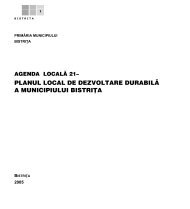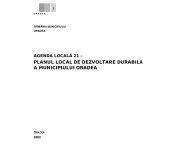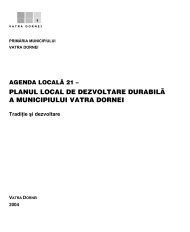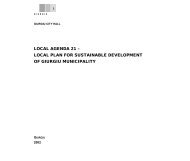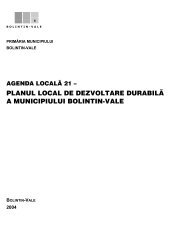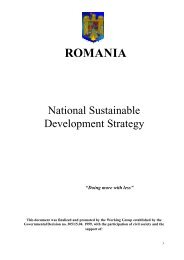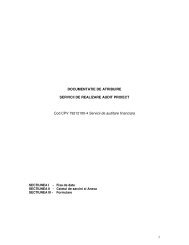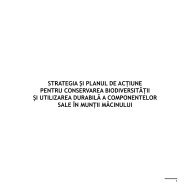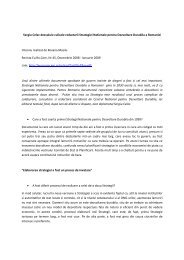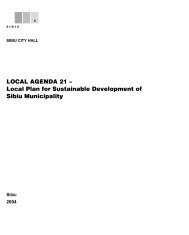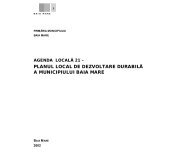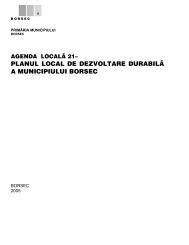local agenda 21 local plan for sustainable development of bistriþa ...
local agenda 21 local plan for sustainable development of bistriþa ...
local agenda 21 local plan for sustainable development of bistriþa ...
Create successful ePaper yourself
Turn your PDF publications into a flip-book with our unique Google optimized e-Paper software.
Brown argiloluviale soils <strong>for</strong>med under the leaf carpet<br />
allow <strong>for</strong> fruit cultivation on large surfaces.<br />
Water<br />
Hydrographical network<br />
Bistrita municipality, the administrative centre <strong>of</strong><br />
Bistrita-Nasaud county, is also the main industrial and<br />
urban centre. The town is situated on the lower course<br />
<strong>of</strong> the river Bistrita, which crosses the city over a<br />
length <strong>of</strong> 18km. The main affluents <strong>of</strong> the river are the<br />
Slatinita, Tarpiu and Ghinda brooks.<br />
The territory <strong>of</strong> the municipality is crossed by the river<br />
Bistrita Ardeleana, which springs in Calimani<br />
Mountains, under the Viisoara-Stracior-Bistricior-<br />
Tuturgau peak and flows into the Sieu River at Saratel.<br />
The river has an annual average flow capacity <strong>of</strong> 7.28<br />
m 3 /s. In the area <strong>of</strong> Bistrita municipality, the river<br />
meets the Ghinda affluent (springing from “Piemontul<br />
Calimanilor") and Castailor Valley (springing under the<br />
Fortress Hills and Ciuha Hills). The flow capacity <strong>of</strong><br />
these brooks is insignificant.<br />
In the north-eastern part <strong>of</strong> the municipality, the course<br />
<strong>of</strong> the river Bistrita has been stopped, creating a small<br />
reservoir <strong>for</strong> flood control and recreation.<br />
The Bistrita Ardeleana River crosses Bistrita in an<br />
east-west direction.<br />
The affluents on the right hand side <strong>of</strong> the river Bistrita<br />
are Slatinitei Valley (in the Unirea district), Rusului<br />
Valley (near the Water Treatment Station) and<br />
Castailor Valley (in M.A.T.- Abator area). The affluents<br />
on the left hand side <strong>of</strong> the river are Ghinzii Valley and<br />
Lempes valley (the area over Budacului bridge).<br />
Drinking water resources<br />
The river Bistrita provides the drinking water source <strong>for</strong><br />
the population <strong>of</strong> Bistrita municipality. Water intake<br />
comes from both surface water (river Bistrita) and<br />
underground water (the everglade <strong>of</strong> the river Bistrita).<br />
The necessary water supply is 30,267 m 3 /day, while<br />
the water request reaches 35,412 m 3 /day. During<br />
2003, a volume <strong>of</strong> 13,693.9 thousands m 3 <strong>of</strong> water<br />
was taken from the following two sources:<br />
• Cusma – with a flow capacity <strong>of</strong> 20.0 l/s (spring<br />
intake, dedusting, old water supply pipeline <strong>of</strong> 150 mm<br />
diameter, doubled by a new supply pipeline <strong>of</strong> 200<br />
14<br />
MUNICIPALITY<br />
mm diameter), Cusma Bistrita, and water storage<br />
tanks with a total volume <strong>of</strong> 1,300 m 3 , <strong>of</strong> which 2 tanks<br />
are 300 m 3 each, and one tank is 700m 3 , in the<br />
Drumul Grinzii area;<br />
• The surface <strong>of</strong> the river Bistrita– using a<br />
complex water treatment station with a capacity <strong>of</strong><br />
1,300 l/s, placed upstream <strong>of</strong> Bistrita municipality, in<br />
the Eastern part <strong>of</strong> the town on the right hand bank <strong>of</strong><br />
the Bistrita Ardeleana.<br />
There is also an underground water reserve with a<br />
flow capacity <strong>of</strong> approx. 60 l/s, which can be used<br />
through drain intakes on the left hand bank <strong>of</strong> the river,<br />
upstream <strong>of</strong> the town. Due to clogging over time, this<br />
source was closed <strong>for</strong> preservation and is currently not<br />
in use.<br />
Mineral water resources<br />
Mineral waters are an important natural resource that<br />
are insufficiently exploited. In the area <strong>of</strong> Bistrita<br />
municipality, it is the salty waters from Slatinita and the<br />
sulphurous waters from Viisoara that are most<br />
important. The <strong>for</strong>mer public baths are situated today<br />
on the administrative territory <strong>of</strong> Feldru commune, with<br />
the main access from Slatinita (2 km).<br />
Soil resources and their productive potential<br />
Due its location in an area <strong>of</strong> geo-morphological<br />
interference, the municipality has slopes <strong>of</strong> varying<br />
degrees <strong>of</strong> inclination. The general slope is between 6<br />
and 8 degrees, while the hills <strong>of</strong> Bistrita and Sieului<br />
have a well developed slope <strong>of</strong> 1 to 3 degrees,<br />
fragmented by several valleys collected by the 2<br />
rivers.<br />
The soils were <strong>for</strong>med on clay and sand deposits. The<br />
level <strong>of</strong> the phreatic water layer varies according to the<br />
relief and the geological structure. On the slopes, the<br />
phreatic layer is situated at a depth <strong>of</strong> over 10m. On the<br />
terraces the phreatic layer is at a depth <strong>of</strong> 2-5 m, while<br />
on the meadow <strong>of</strong> Bistrita and Sieu it is at 1.5-2 m.<br />
Through constant and systematic action, natural<br />
factors determine the <strong>for</strong>mation <strong>of</strong> the following soil<br />
types:<br />
- Brown soil - argiloiluvial pseudogleizat<br />
- Brown soil – moderate luvic pseudogleizat



